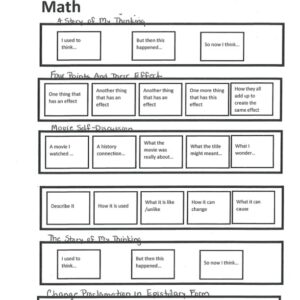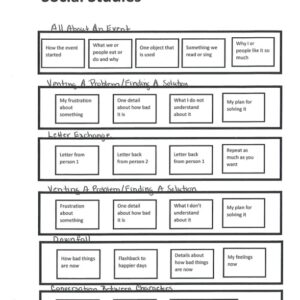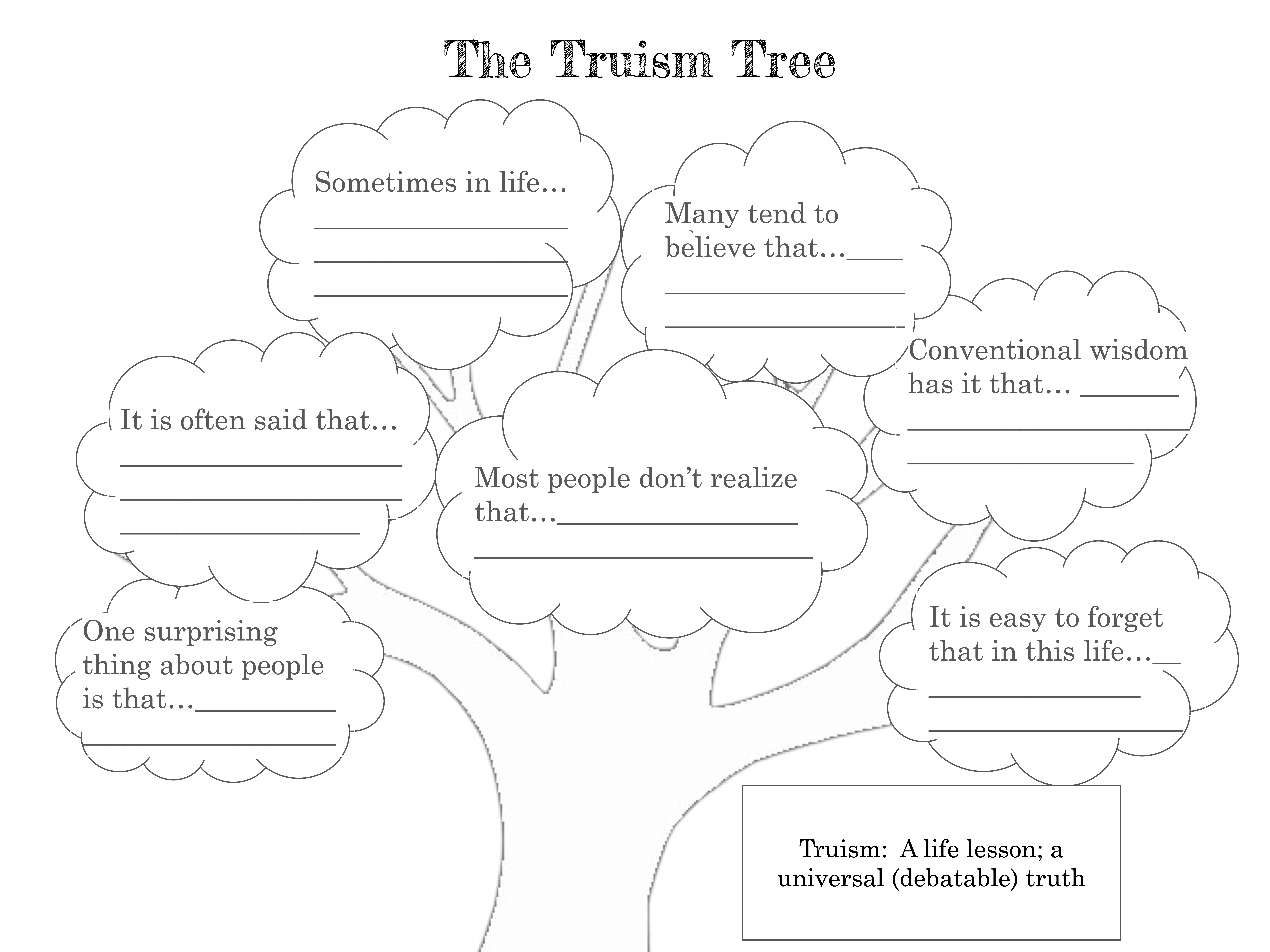

Writing for a Reader
When we write for ourselves, we already know what we’re picturing. We already contain the context. But when we are writing something for someone else to receive and read, we have to continually imagine that they can’t read our minds. We have to compose our words in a way that we give the reader an experience, no matter what kind of writing it is. It must be clear, and it must be interesting enough to keep the reader listening in.
Kernel Essays
A writer writes about the topic, using the text structure as a guide, creating one sentence per box. These sentences are called a kernel essay. The next step is for the writer to read the kernel essay aloud to several listeners to see how that structure worked for the writer. Peter Elbow calls this a “skeleton essay.” If the writer wants to develop this into a full essay, all the sentences need now are details and craft.

Kernel Essay Process by Allie McCarron

Writing with Gretchen Bernabei #1-- Kernel Essays

Quicklists and Kernel Essay--Or Writing an Essay With Some Structure

Let's Write a Kernel Essay with Gretchen Bernabei: A Controversial Decision

Glossary of Terms

Planning Sheet

Sample: Avery’s Balloon

Adding Details to Kernel Essays

Quicklist #2 and Kernel Essays

Crunchtime Countdown Quick List

Self-Guided Practice

11-Minute Essay

Kayla and Stephen Briseño Walk Through the 11-Minute Essay

Elementary Students Share Their 11-Minute Essays

Grid for Topics with Words by Daina Land
Text structures.
The text structure is the plan, or path, that a writer uses, in order to “track movement of the mind.” In other words, the structure will allow a reader to glimpse what you know, and how you know it. Text structures can be revised to make them work for the writing situation. They can be created intentionally by a writer or gleaned from reading. For simplicity, we place these steps into sequenced, horizontal boxes, resembling stepping stones.
Check out Gretchen’s explanation of text structures and kernel essays in this presentation .

A Growing Collection (22 pages)

Comic Text Structures (119 pages)

Informational Text Structures

Persuasive Text Structures

Argument Text Structures (English)

Argument Text Structures (Spanish)

Basic Informational Text Structures

Greatest Hits for My Gritty Life Text Structures

Text Structures: Alternatives to the Schoolified Essay

Text Chunkyard

Kernel Essay #1&2 Memory Text Structure

Text Structures for Reflections

Text Structures for Reflections (Spanish)

Text Structures for Math by Janette Wilcken

More Text Structures for Math by Glenna Edgin

Text Structures for Science by Janette Wilcken


More Text Structures for Science by Glenna Edgin

Text Structures for Social Studies by Janette Wilcken

More Text Structures for Social Studies by Glenna Edgin

Text Structures for Current Events by Janette Wilcken

Text Structures for Electives by Glenna Edgin

Text Structures for Nursery Rhymes Comic Book by Paul Erickson

Colored Comic Pages from Training of Trainers 2019

Colored Comic Pages from Training of Trainers 2022

Academic Writing Comics by Tara Temprano

Ba-Da-Bing Comics by Tara Temprano

Infoshots and Cubing Comics by Tara Temprano

Text Structures from the Masters Comics by Tara Temprano

Three Things Response Comics by Tara Temprano

A Treasure of Ways to Use Text Structures from Advanced Learning Academy

Text Structures from Nursery Rhymes Additional Resources English by Adriana Arce

Text Structures from Nursery Rhymes Spanish Resources by Adriana Arce
Truisms are life lessons, statements that are true for most people. Written in third person, present tense, they are sentences which are generally about the world, about people, or about life. They are also called “thematic statements.” They might be the thesis statement of an essay, or the claim in an argument, or embedded as a detail. They are always debatable. They are not written as imperative sentences.

Teaching Truisms

Truism Dude

Truism Tree adapted by Valerie Garza

Kayla and Stephen Briseño Explain the Power of Truisms

89 Visual Prompts

Visual Writing Prompts: Lessons from Childhood (48 pages)

Visual Writing Prompts: Life Lessons of Adolescence (120 pages)

Visual Writing Prompts: Coming of Age (28 pages)

Visual Writing Prompts: Thumbnails (19 pages)

Discovering Truisms and Themes Through the Study of Photographs by Maureen Ucles (16 pages)

Truisms for 4th Grade in English and Spanish by Leslie Platas (7 pages)

One Way to Begin Teaching Truisms (7th grade example)
Correspondence.
When writers are having trouble knowing how to sound, Sandra Cisneros advises them to find their voice by imagining talking to someone so close that it feels natural talking to them in pajamas. It’s also easier to write when it’s in the form of a letter, being delivered to someone. And these days, when people feel so disconnected from other people, writing letters is a wonderful way to connect, both intellectually and emotionally. Furthermore, letters make it easier to understand the writer’s purpose. (Selling me something? Inviting me somewhere? Needing something?)

Unsent Messages Idea Bank

Unsent Messages 1-6 (9 pages)

Unsent Messages: Supporting Writing and SEL
All materials copyright © 2024 Trail of Breadcrumbs. All rights reserved. Website by Websy Daisy .
Synthesizing
Synthesis pre-writing strategy: the kernel essay.
Synthesis Essay Pre-Writing Strategy: The Kernel Essay
What is a kernel essay? A kernel essay is a shortened form of a broader essay (usually a few paragraphs long) that emphasizes understanding how to format a claim (also known as thesis statement) and provide evidence for that claim. The goal is that a kernel essay could then be extended into a full essay. So how do I organize this?
Key Takeaways
Synthesis Kernel Essay Format:
- Introduce both texts (authors, titles, and common themes/traits.
- Based on these texts, I believe… (this is your claim)
- An analysis of Author 1’s argument (claim, evidence, limitations)
- An analysis of Author 2’s argument (claim, evidence, limitations)
- What these authors would say to one another (what they would agree with? How they would challenge one another?
- What you think…
- Why any of this is important (also known as a final evaluation or commentary)
Based on your own sources, consider the questions above to brainstorm synthesis notes. Then, use the sample below to model your own kernel essay.
Example Synthesis Kernel Essay:
In Charlie Beck and Connie Rice’s “How Community Policing Can Work” and Charles M. Blow’s “Romanticizing ‘Broken Windows’ Policing,” all three authors discuss the need for programs that bring attention to wrongful use of force among police. However, each source focuses on a different program: Beck and Rice highlight the positive aspects of “guardian policing” while Blow criticizes the negative aspects of “broken windows policing.” Though different programs have advantages and disadvantages, I think all authors could agree that exploring programs to help reduce violent crime as well as police use-of-force is necessary in combating many tragedies we see in America today; however, the authors make interesting points about the importance of considering the causes of crime within individual communities.
Beck and Rice, one the “chief of the Los Angeles Police Department” and one a “civil rights lawyer,” provide evidence that guardian policing, which consists of having police officers establish trust with residents in high crime neighborhoods in Los Angeles, has been found to reduce the number of murders as well as the number of police shootings. In fact, since it began in one particular neighborhood named Watts, there have been “no shootings by the partnership officers in over five years” (Beck and Rice). However, within this piece, Beck & Rice fail to discuss other potential solutions other than guardian policing, making this program seem the one-stop solution.
Charles M. Blow, though clearly an advocate for programs that would train officers in ways that may reduce their use-of-force in unnecessary situations, asks us to be wary before simply accepting any program as the savior for today’s problems. He highlights a misguided program called “broken windows policing” for targeting certain racial groups, primarily African American communities, as violent, when that’s not necessarily the case. He writes, “How you view “broken windows” policing completely depends on your vantage point, which is heavily influenced by racial realities and socio-economics,” (Blow) and emphasizes the need for police officers to view effects of poverty before tying violence to race.
Both texts make valid points for the need for more programs to help reduce unnecessary use-of-force among police. Though Blow’s piece is focused more on racial discrimination, he highlights strong points about the role poverty plays in a lot of these situations. Beck & Rice consider community trust at the heart of the problem of some of the crime we see in neighborhoods. I believe Blow’s points challenge Beck & Rice in a positive way, encouraging readers to consider the many facets that contribute to crime in communities and consider ways to combat this issue that is specific to the community members the program works to target.
- Adapted from Gretchen Bernabei's Trail of Breadcrumbs. Authored by : Amber Nichols-Buckley . Located at : http://trailofbreadcrumbs.net/writing-strategies/kernel-essays/ . Project : Trail of Breadcrumbs. License : Public Domain: No Known Copyright

IMAGES
VIDEO